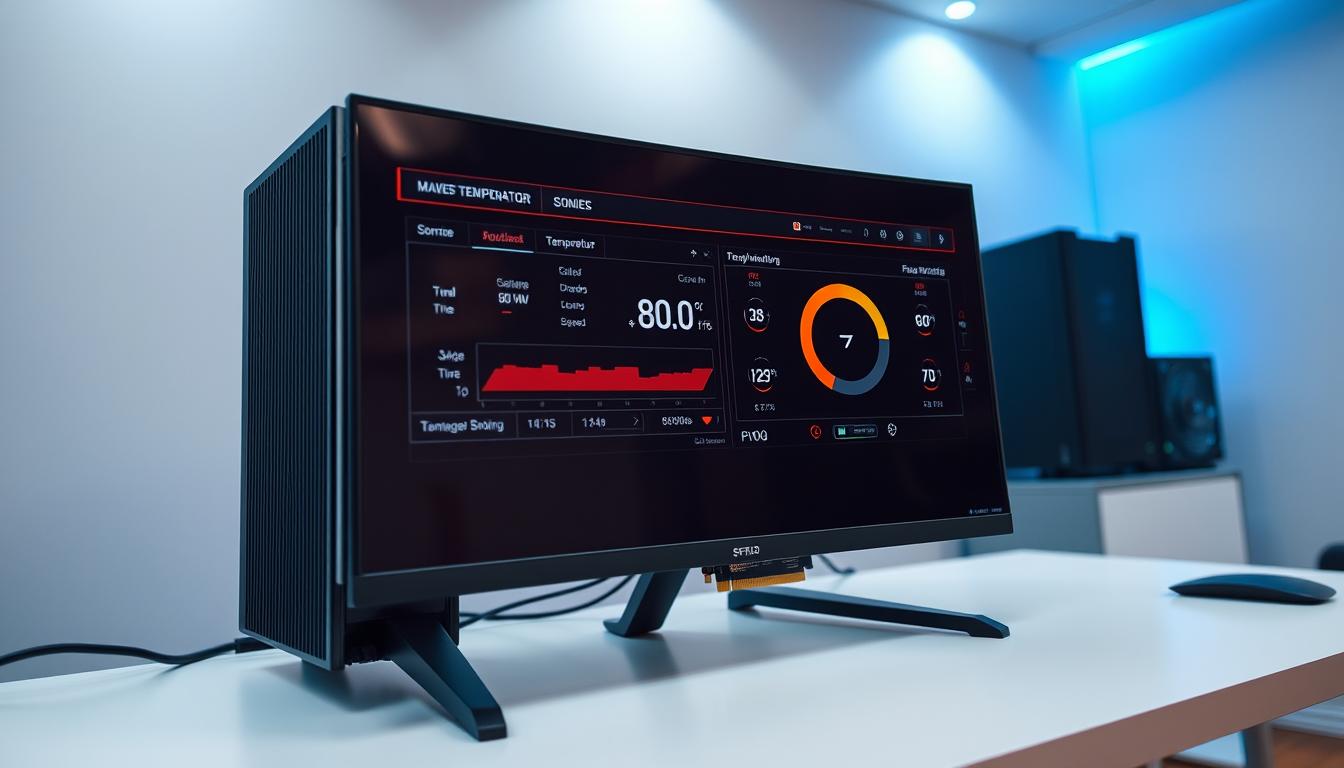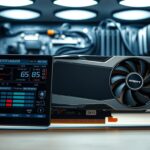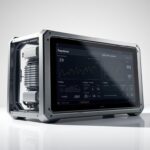Last Updated on August 20, 2025 by Gill
Remember that heart-pounding moment when your screen froze mid-game? I do. Last summer, my trusty rig suddenly shut down during a marathon session, leaving me staring at a black screen – and a lesson learned about heat management.
Your graphics card works like an athlete. At rest, it barely breaks a sweat. Under pressure, it pushes limits. But just like humans, every component has its thermal breaking point. Modern NVIDIA models typically stay safe below 85°C during intense tasks, while AMD cards handle up to 100°C before throttling kicks in.
Why does this matter? Prolonged high temperature exposure can turn your gaming powerhouse into a paperweight. Those RTX 30-series cards you love? They start sweating at 93°C. Older GTX models might tolerate slightly higher heat, but why risk it?
This guide isn’t about fear – it’s about empowerment. We’ll break down manufacturer specs into plain English, show you how to track your system’s performance, and share cooling tricks that actually work. Whether you’re battling dragons or rendering 3D models, understanding these numbers means protecting your hardware investment while squeezing out every frame.
Let’s turn those anxious glances at monitoring software into confident nods. Your graphics card deserves that peace of mind – and so do you.
Introduction to GPU Temperature Basics
Think of your graphics card as a high-performance engine – it needs proper airflow to avoid overheating. Every gaming session or rendering task pushes its components to convert power into visual magic, creating heat as a natural side effect.
How Heat Shapes Performance
Modern GPUs use three layers of defense against rising temps: copper heat spreaders pull warmth away from cores, thermal paste fills microscopic gaps, and fans push hot air out. These systems work together during operating sessions to maintain safe conditions.
Why Vigilance Matters
Ignoring temperature warnings risks more than laggy gameplay. Prolonged exposure to high heat can warp circuit boards and degrade solder joints over time. Regular checks help spot cooling issues early, protecting your hardware’s longevity.
Sudden shutdowns aren’t just annoying – they’re red flags. Consistent monitoring lets you catch fan failures or dust buildup before they cause permanent damage. Smart gamers track their temps like athletes monitor heart rates.
Defining Safe Temperature Ranges for GPUs
Your graphics card’s thermal limits work like a car’s speedometer – green zones mean smooth sailing, while red zones demand immediate action. Manufacturers design these safeguards to balance performance with component protection.
Understanding Industry Standards and Ranges
NVIDIA and AMD set different thresholds based on chip architecture. Current RTX 30-series cards throttle at 93°C, while AMD’s RX 6700 XT pushes boundaries up to 110°C. These engineering specs account for materials, power draw, and cooling solutions.
Three key ranges matter:
- Cool & Collected: Below 55°C (idle) or 85°C (max load)
- Warming Up: 55-80°C (idle) or 85-95°C (load)
- Danger Zone: Anything above those upper limits
Comparing Idle and Load States
At rest, components sip power. Modern cards should stay under 55°C when browsing or watching videos. Under stress tests or 4K gaming, thermal management kicks into high gear.
Consider these benchmarks:
- RTX 2080: 42°C idle vs 74°C load
- RX 6800: 48°C idle vs 82°C load
Newer models handle heat better through improved cooling designs. But consistent high temps – even within manufacturer limits – can shorten hardware lifespan. Track both states to spot cooling issues early.
Thermal Performance Across Usage States
Your graphics card tells two different thermal stories – one during downtime, another when pushing pixels. Recognizing these patterns helps maintain peak performance while avoiding hardware stress.
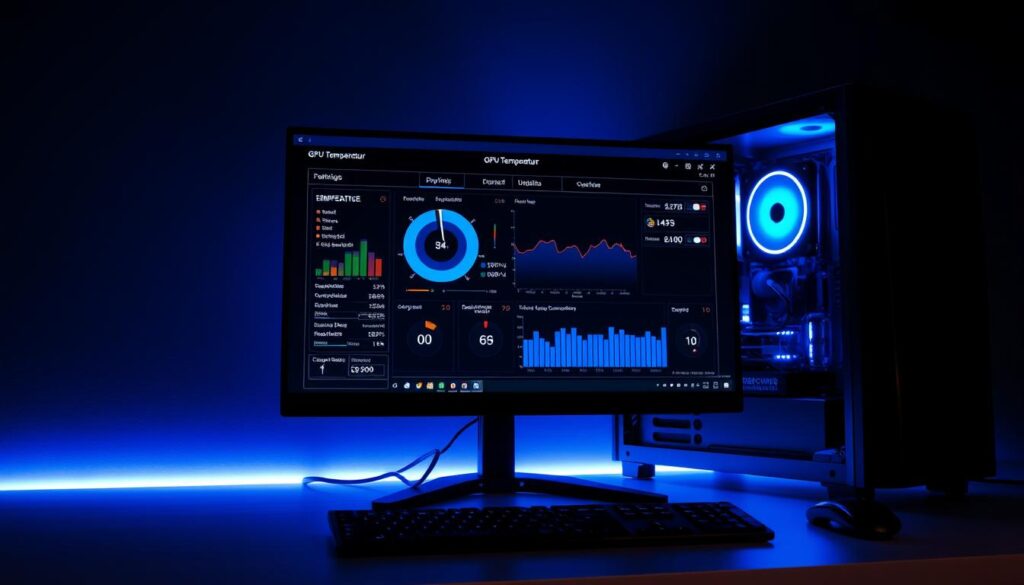
Identifying Temperature Metrics During Idle
At rest, components should whisper rather than shout. Healthy systems show 30-50°C when browsing or streaming. This thermal calm indicates effective cooling during light tasks.
Check these benchmarks after 10 minutes of inactivity:
- RTX 3080: 38°C average
- RX 6800 XT: 43°C typical
Consistent spikes above 55°C suggest background processes or cooling issues. Dust-clogged fans often cause elevated temps during downtime.
Evaluating Temperature Under Load
Demanding gaming sessions transform thermal dynamics. Modern cards handle 70-85°C safely, but smart users aim lower. NVIDIA’s 80°C threshold balances performance with longevity.
Compare these stress test results:
- RTX 4070 Ti: 72°C under max load
- RX 7900 XTX: 81°C peak
Sustained readings near manufacturer limits (90°C+) risk thermal throttling. Track temperature trends across multiple sessions – sudden increases signal cooling degradation.
Pro tip: Benchmark after driver updates. New optimizations sometimes increase power draw temporarily.
Factors That Influence GPU Temperatures
Managing your graphics card’s thermal behavior resembles coaching a sports team – every component must work in harmony. Three core elements dictate performance: internal cooling, environmental conditions, and physical setup.
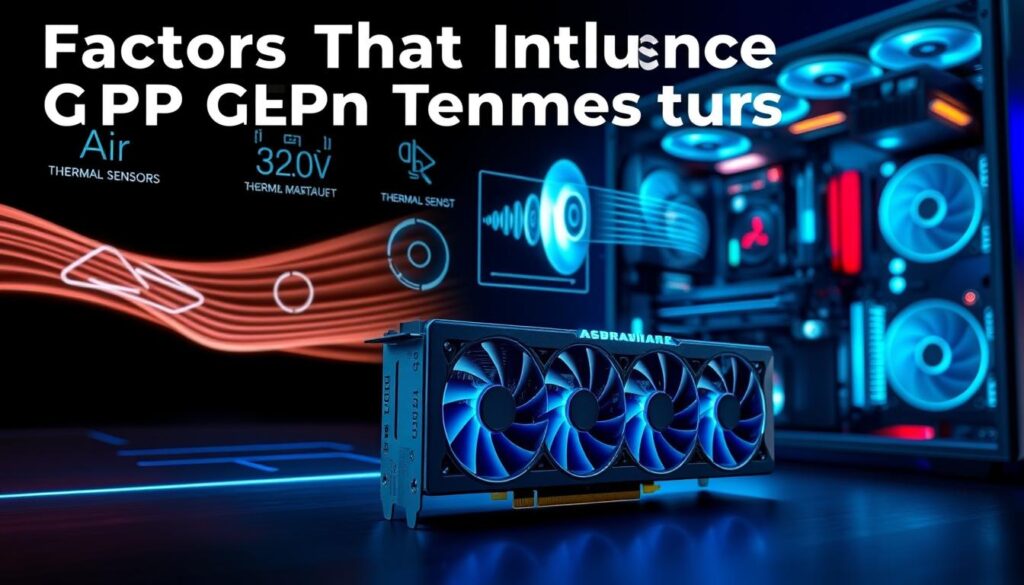
Cooling Systems, Fans, and Airflow Considerations
Your graphics card’s built-in cooling system acts as its personal trainer. High-end models use triple fans and vapor chambers to push heat away from critical components. Budget cards might rely on simpler designs, struggling under heavy loads.
| Component | Impact | Optimization |
|---|---|---|
| Fans | Direct airflow over heatsinks | Clean regularly, replace worn bearings |
| Heat Sinks | Dissipate core heat | Upgrade to copper models |
| Thermal Paste | Transfers heat to cooler | Reapply every 2 years |
| Case Design | Affects airflow paths | Use mesh-front cases |
| Ambient Temperature | Sets baseline cooling | Maintain 72°F room temp |
Case airflow patterns determine whether hot air escapes or recirculates. Front-to-back or bottom-to-top layouts work best, with intake fans matching exhaust capacity.
Impact of Case Design, Ambient Temperature, and Dust
Your PC’s case functions like a climate-controlled stadium. Compact builds trap heat, while spacious towers allow better circulation. Glass panels might look sleek, but mesh sides improve thermal performance by 15%.
Room conditions play a hidden role. A 75°F environment keeps components 10°C cooler than an 85°F space. Summer gaming sessions often require adjusted fan curves.
Dust bunnies aren’t harmless – they form insulating blankets on cooling fins. Monthly compressed air cleaning prevents up to 12°C temperature spikes. Focus on fan blades and ventilation grilles during maintenance.
How to Monitor and Test Your GPU Temperature
Your computer’s graphics card whispers its thermal secrets through specialized tools – learning this language keeps your system healthy. Modern monitoring solutions range from basic Windows utilities to advanced diagnostic software, giving users multiple ways to check temperature during different tasks.
Essential Monitoring Tools Compared
Start with the built-in Task Manager for quick checks. Press Ctrl+Shift+Esc, navigate to the Performance tab, and find your graphics card’s current status. This utility requires no downloads, making it perfect for casual users.
Enthusiasts prefer feature-rich programs like MSI Afterburner. This tool displays real-time stats while allowing fan speed adjustments and overclocking. For comprehensive system analysis, HWiNFO tracks every component simultaneously – ideal for diagnosing heat-related bottlenecks.
| Tool | Features | Best For |
|---|---|---|
| Task Manager | Basic temperature readouts | Quick system checks |
| MSI Afterburner | Overclocking controls + monitoring | Performance tuning |
| HWMonitor | Detailed component statistics | System-wide analysis |
| Unigine Valley | Stress testing capabilities | Load temperature evaluation |
Stress testing reveals how your hardware behaves under pressure. Run benchmarks like Unigine Valley for 20 minutes while monitoring software tracks thermal responses. This helps identify cooling issues before they affect daily computer use.
Regular monitoring establishes performance baselines. Compare readings across different programs to ensure accuracy. Smart users check temperatures monthly – more often if pushing hardware limits through demanding tasks.
Strategies to Optimize GPU Cooling
Ever felt your PC case transform into a mini oven during gameplay? Smart thermal tweaks can turn that heat wave into a cool breeze. Let’s explore proven methods to keep your hardware chill without breaking the bank.
Fine-Tuning Fan Behavior
Custom fan curves unlock hidden cooling potential. Most software lets you set fan speed thresholds – try 40% at 50°C ramping to 80% at 75°C. This proactive approach prevents thermal spikes before they occur.
| Setting | Stock Profile | Optimized |
|---|---|---|
| Idle Speed | 30% | 40% |
| Mid-Load Target | 60% @ 70°C | 70% @ 65°C |
| Max Temp | 83°C | 75°C |
Undervolting reduces power draw without sacrificing performance. Drop voltage by 50mV increments while stress-testing stability. Many users achieve 5-8°C reductions this way.
Airflow Revolution
Messy cables create roadblocks for airflow. Use velcro straps to route wires along case edges. This simple fix can lower GPU temps by 3-5°C in cramped builds.
Consider these upgrades for stubborn heat issues:
- Aftermarket coolers with larger heatsinks
- Case fans that match your chassis size
- Thermal paste replacement every 2 years
Remember: Good cooling isn’t about brute force. It’s creating harmony between fan settings, hardware layout, and smart power management.
Integrating CPU and GPU Temperature Management
Your computer’s cooling system works like a symphony orchestra – every part must harmonize to prevent thermal chaos. Processors and graphics cards share airflow paths and case space, meaning one component’s heat directly impacts the other’s performance.
Balancing Cooling Solutions for Overall System Performance
CPUs typically idle between 30-50°C, while GPUs hover slightly higher. Under load, both components push boundaries: processors peak near 85°C, graphics cards up to 95°C. These temperature ranges overlap, creating thermal handshakes that demand smart airflow planning.
Three rules for synchronized cooling:
- Prioritize exhaust paths – hot air from your graphics card shouldn’t blow toward the CPU cooler
- Match fan curves – coordinate case fan speeds with both component temperature readings
- Upgrade strategically – liquid cooling for processors often benefits GPU performance through reduced ambient heat
Maintaining normal CPU temp ranges (below 75°C under load) helps keep the entire system stable. Remember: a 10°C drop in processor heat can lower GPU temperature by 3-5°C through improved case airflow.
Smart users treat their hardware as interconnected partners. Regular cleaning and thermal paste replacements benefit both components, while proper cable management ensures smooth airflow between them. Your cooling system isn’t just fans and heatsinks – it’s the careful balance between two powerhouses working in thermal tandem.
FAQ
How hot should my graphics card get during regular use?
Why does my GPU run hotter when gaming?
Can high room temperatures damage my components?
What tools can I use to track GPU temps?
How often should I clean my PC to avoid overheating?
Does overclocking always lead to higher temperatures?
Can poor cable management affect GPU temps?
Is it normal for temps to vary between GPU brands?
- Optimize Your GeForce RTX 5070 Performance with Our Bottleneck Tool - October 2, 2025
- GeForce RTX 5090 Bottleneck Calculator: Optimize Your Setup - October 1, 2025
- GeForce RTX 5080 Bottleneck Calculator: Optimize Your Setup - September 30, 2025

